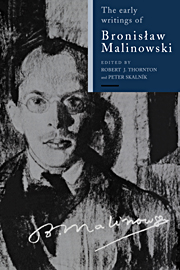Book contents
- Frontmatter
- Contents
- Preface
- Acknowledgements
- Note on the text
- Introduction: Malinowski's reading, writing, 1904–1914
- Malinowski's writings, 1904–1914
- 1 Observations on Friedrich Nietzsche's The Birth of Tragedy (1904/5)
- 2 On the principle of the economy of thought (1906)
- 3 Religion and magic: The Golden Bough (1910)
- 4 Totemism and exogamy (1911–1913)
- 5 Tribal male associations in Australia (1912)
- 6 The economic aspects of the intichiuma ceremonies (1912)
- 7 The relationship of primitive beliefs to the forms of social organization (1913)
- 8 A fundamental problem of religious sociology (1914)
- 9 Sociology of the family (1913–14)
- Notes
- References
- Index
7 - The relationship of primitive beliefs to the forms of social organization (1913)
Published online by Cambridge University Press: 18 December 2009
- Frontmatter
- Contents
- Preface
- Acknowledgements
- Note on the text
- Introduction: Malinowski's reading, writing, 1904–1914
- Malinowski's writings, 1904–1914
- 1 Observations on Friedrich Nietzsche's The Birth of Tragedy (1904/5)
- 2 On the principle of the economy of thought (1906)
- 3 Religion and magic: The Golden Bough (1910)
- 4 Totemism and exogamy (1911–1913)
- 5 Tribal male associations in Australia (1912)
- 6 The economic aspects of the intichiuma ceremonies (1912)
- 7 The relationship of primitive beliefs to the forms of social organization (1913)
- 8 A fundamental problem of religious sociology (1914)
- 9 Sociology of the family (1913–14)
- Notes
- References
- Index
Summary
THE THEORY OF TOTEMISM
Generally recognized methods and established basic concepts continue to be lacking in the ethnology and sociology of primitive peoples. Therefore in undertaking special research on some definite subject in the field of ethnology one must try to deepen the method and establish general principles. The present attempt to outline a new theory of totemism also lays claim to certain improvements in the method of defining ethnological phenomena as well as in the manner of presenting the genesis of these phenomena; it also purports to verify certain general principles in the concrete example of totemism. Totemism is an extremely fashionable subject in present day ethnology. Limiting ourselves to the best known and most significant works, we can mention the great treatise of Frazer and the most recent works of Durkheim and Wundt. Totemism is also a concept widely used by related and auxiliary sciences, such as archaeology and ancient history. However, despite the fact that so much has been written about this subject, neither the concept of totemism nor the viewpoint of its origin has been definitively established so far. The authors agree neither on what totemism is nor how it arose.
Thus, we are faced with two major problems: defining the essence of totemism and providing its genesis. The former problem is neither superfluous nor easily solvable, as is evident from the fact that the term, ‘totemism’ designates a set of heterogeneous and loosely connected phenomena. This concept encompasses beliefs about man's union and close relationship with an animal, plant, or inanimate object, all of which we designate with the name ‘totem’.
- Type
- Chapter
- Information
- The Early Writings of Bronislaw Malinowski , pp. 229 - 242Publisher: Cambridge University PressPrint publication year: 1993

